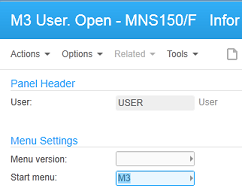Managing M3 Menus in the Navigator
Infor Smart Office retrieves its M3 menu from the settings in MNS110 and MNS111 every time the user logs on to M3. Every user will then have his own unique menu, depending on the security settings for the user in M3 Business Engine. An MI transaction called MNS111MI.ListAllAuth() is used to get the menu from a M3 Business Engine system. Only menu items that the user is authenticated to use will be shown in the menu. The MI program is called through the M3 API WS.
The menu is retrieved for the language the user has set in MNS150. For this to work, the menu in M3 Business Engine must have been generated for that specific language. To generate the menu for a specific language, first check that the language exists in Business Engine in MNS105, if it does exist start MNS910 and use option 1 to generate the menu for the language. For information about how to manage the M3 menu, see the Business Engine documentation.
When the menu is retrieved, a timestamp is also retrieved from Business Engine. A request to retrieve the menu together with the timestamp is sent to Business Engine every time that Infor Smart Office is started. If the timestamp has not changed in Business Engine, the menu will not be updated on the client unless the user has changed company, division or language.
The following image shows a user connected to the blank (default) menu version.

-
The Start menu is not used in Infor Smart Office.
-
Menu versions are created in MNS080, and the menu versions can be connected to users in MNS150. The MI program MNS111MI.ListAllAuth() only returns menu entries that the user is authorized to use. Therefore, different users can have different menu trees in Infor Smart Office even though they are connected to the same menu version. A user can be allowed to use different programs in different companies and/or divisions.
This document does not describe how to set up menu security. It is only to be considered as a starting point for creating menus. The Business Engine documentation contains information about how to create a menu.
The default menu version is the blank menu version.
The menu in the Navigator is in fact the menu version for the user. When you work in MNS111 and build the menu version, it is important that the correct menu version is selected. It is easier to manage menus if you keep one menu version and just add entries to it. Then by setting up security for the functions, only the functions available to the user will be displayed.
There is no way to connect a menu version to a group in the Business Engine.
The task "How to add a new function to the menu" is described below.
Translations of added functions such as IBrix are not supported. In order to have new menu items language-managed, the language files must be regenerated and constants must be added for the new menu function.